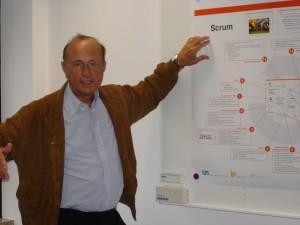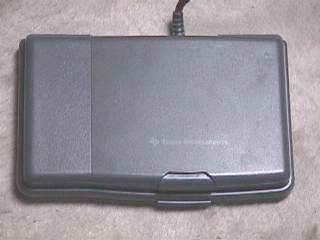
A short time ago, I read the article that was supposed to answer the question:
”What tools does a product owner need?“
It was a long article. Quite a few reasonable things can be found in said article and it is not bad. Much of it sounded thought through.
However, the more of it I read, the less comfortable I felt. Because somehow or other, it did not seem to be correct. To be sure, tools can certainly be useful once in a while. But today, we use so many tools that, more often than not, we do not see the wood for all the trees.
Consequently, I asked the “tool question” for other white collar jobs from my professional world:
“What tools does a scum manager need, a project manager, a quality manager, a requirement engineer or a leader in general, who today is also called manager and who even needs to be know “digital leadership“?
(You all know my reservations about all these buzzwords you can formulate as you wish by using the words digital, smart, manager, leadership, project and others of the kind.)
And I feel confirmed that we believe too much in tools. They are not really all that useful and they mostly distract us from what is really important – which is hard enough to find.
As a next step, I tried to remember what role tools have had in my life. I can no longer remember the tools I worked with when I built sand castles. At school and at university, however, I used (my) handwriting and books. In some few cases, there was a pair of compasses, a ruler, a slide rule, a logarithmic table and, once, the typewriter (when I wrote my diploma thesis).
The bicycle was extremely important – without it, I would not have been able to reach the school. Yes – I almost forgot – in mathematics, my common sense was also necessary.
Immediately after my intermediate exams, in the early 1970ies, I started programming for Siemens as a working student (at TUM, it had been more like playing games). I became a software engineer.
My tools were programming forms and paper. I also had one of the famous Siemens pressure pens the secretaries were always so reluctant to hand over. The form had 80 columns that were printed following the assembler syntax.
Incidentally, the assemblers for the Siemens Series 300 process computers were called “prosa”.
? Warning: the following part is for experts, for instance programmers.
If I remember correctly, then the first 8 columns on the form were for the “jump marks”, also called “labels“. Then there were special columns where, among other things, you marked if the left or the right accumulator was to be used. The last 8 columns (numbers 73 to 80) were for numbering. When starting a new program, you were well advised to execute it in a hundred steps, which left room for extra additions. Column number 72 was for the start of the next card. This, or something like it, was how you did it.
With the pressure pen, I drew some sorts of “process images” onto the white paper, and then I transferred these into orders on the form. Then, some assistants transferred the form into punch cards. There was one punch card for each line. The line was typed twice. First the holes were punched and then, during the second phase, the punched card was controlled. This is how the program was created as a series of punch cards.
A box or at least a rubber band for the punch cards were also important tools. Later, I was also given a portable punching machine, because I was allowed to patch corrections when seeing a customer. This was a huge distinction and I was truly proud of it.
Additionally, I had another tool of a totally different category. It was the thin and very well-structured Siemens calendar (for the OFK, the upper leadership, it was leather bound).
That was all and it was totally sufficient as far as tools are concerned. I still remember how, at the time, I bought a luxury tool from my private funds. A Texas Instruments wonder calculator. But that was more of a hobby and not really necessary – which is why I had to pay the approximately 600 DM from my own pocket. But my enthusiasm, and apparently also my income, were huge enough to cover it.
This calculator offered the octal (numbers 0 – 9) the se-decimal, and also the hexa decimal system (with numbers 0 – F – where numbers 0 – 9 were extended with A, B, C, D, E and F) and also made all the transformations. It was occasionally a useful tool, but above all it was something you could really show off with.
Please note what goes without saying: Of course, all calculators were based on the binary system and could only compute zeros and ones. They used the binary system (0 and 1). The first “dumps” were only zeros and ones and we needed to be able to read them.
Since in the binary system the notation tends to become rather lengthy, they quickly established bigger units that consist of two half-words, the bytes. For the process calculators, the “word” had 2 times 3 bits (so the byte still had three digits), whereas most other systems had the basic unit 4 Bit (= 1 Byte). The languages with the three bits were octal, those with the four bits se-decimal.
Consequently, the dumps became smaller and, depending on the assembler, consisted of the numbers 0 to 7 or 0 to 9, extended by the letters A – F.
To this day, I remember that one of the assemblers I programmed had the se-decimal word 07FF (binary expression: 0000 1110 1111 1111) for the machine command “release control”. I forgot everything else.
? Here comes more for managers.
Later, I replaced the Siemens calendar with an “Löhn Kalender” It was a small ring binder (also rather expensive) with many compartments that more or less had the functions of today’s outlook. You could buy it in plastic or real leather. It did not take long before I had the leather version. This tool supported my lengthy metamorphosis from being a programmer to being a manager/entrepreneur.

 There was a huge disadvantage to the “Löhn” calendar: it could not talk. Consequently, I missed appointments in my life as a manager because I was so fascinated with my work as a programmer that I never realized how quickly time had flown.
There was a huge disadvantage to the “Löhn” calendar: it could not talk. Consequently, I missed appointments in my life as a manager because I was so fascinated with my work as a programmer that I never realized how quickly time had flown.
This is why I did not remain faithful to the “Löhn” calendar and substituted it with an electronic assistant. It was a Texas Instruments device that used to be part of the Electronic Organizer family (Personal Organizer).
Its functions were fewer than those of the “Löhn”, but it could make a wake-up noise. Thus, I always heard it when, shortly before my appointments, it gave a bleep, which meant that my arrival on time for my appointments was drastically improved. And if you compare the price with that of my TI calculator for octal, decimal and se-decimal calculations, the small miracle system was almost cheap.
Incidentally, these devices were later combined to become the, also new, mobile telephone. For me, the mobile phone and the organizer are something like the father and mother of our modern “Smart Phone“.
So much on my own tool history, which later continued with the use of my laptop, airbook and tablet.
What tools does a leader need?
This question is about as silly as asking: “what tools does a cook need?”, without mentioning what the cook is supposed to cook. The only answer I can think of is: “his common sense and probably a kitchen knife”.
The correct question would be what tools will a person need in order to prepare a certain meal. If I want to feed my guests cheese fondue, then this is totally different from potato dumplings or fried chicken or raspberry ice cream or goulash out of the tin! If I want cheese fondue, then the most important ingredient is high-quality cheese with the right taste (which is also true for Swabian Käs-Spatzen). And the right wine. And the right white bread. As you see, it is not the tools that make the difference, but the ingredients!
Now you might counter that you cannot really compare a leader personality with a cook. Because, after all, the latter is a craftsman who, in the end, will serve something tangible and hopefully reasonable.
So we are looking for a job that comes closer to that of a leading personality? The pastor comes to mind. It is probably a better fit, because you do not get a result you can eat. The same is true for the manager.
SO: What tools does a pastor need?
I would say:
The bible and his spectacles if he cannot see too well any more. But perhaps, today, he has a bible download on his tablet. And if he needs an excel, then he made a mistake. Just like the leader.
RMD
(Translated by EG)

